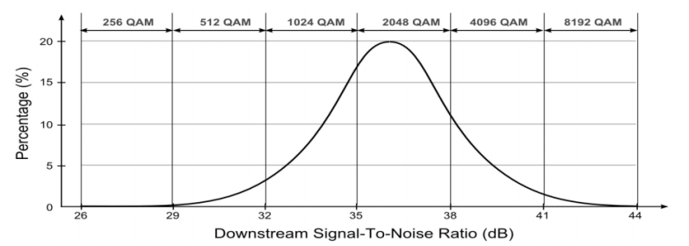Updated August 27, 2019
Originally published in October 2015, this technical guide is designed to equip network professionals with the information they need to fully understand DOCSIS 3.1, and to leverage the standard’s capabilities to provision next-generation cable services.
Fast forward to 2019! Incognito is pleased to provide a number of updates on our DOCSIS 3.1 technical guide. This part 2 blog builds on the DOCSIS 3.1 capacity improvements detailed in part 1 of the series.
Happy reading!
Sonya Goodanetz
Solutions Marketing - Incognito Software
Error Correction
All previous versions of DOCSIS employed FEC (forward error correction) addressing BER (bit error rate), the rate at which errors occur in the signal due to degradation. DOCSIS 3.1 increases efficiency via additional error correction methods. In DOCSIS 3.0 the FEC algorithm specified is Reed Solomon (RS) which provided a decent coding gain of approximately 6dB compared to the un-encoded stream. In North America, coupled with Trellis Coded Modulation (TCM), the end result is an extra 2dB gain.
During DOCSIS 3.1 standard development, the committee considered additional error correction methods. One suitable method included low-density parity-check (LDPC); used in later versions of Wi-Fi 802.11 and Digital Video Broadcasting (DVB). Although LDPC is more computationally expensive but less intensive than Turbo Codes, modern application-specific integrated circuit and DSP / SoC are powerful enough to easily incorporate the FEC mechanism, providing options to both the headend and CPE. If the DSP or FPGA is robust, FEC capability can be enabled via a software upgrade; as implemented by numerous CCAP vendors. Operators yield approximately 6dB gain over DOCSIS 3.0 Reed Solomon method, shrinking the gap to the theoretical Shannon Limit at only 1dB for the spectral efficiency vs. signal to noise ratio. The LDPC encoding efficiencies impact modulations directly – LDPC results in a 2bps/Hz efficiency; so a 6MHz downstream channel can effectively transmit an additional 12Mbps.
Modulation
Prior to DOCSIS 3.1, the maximum 64-QAM (upstream) and 256-QAM (downstream) were the maximum modulations possible. LDPC FEC introduced a 22.5dB signal to noise ratio, an enhancement to 27dB signal to noise ratio. So higher-order modulation is now possible. Let’s tackle an example for 1024-QAM where the required signal-to-noise ratio (SNR) using LDPC is equivalent to 256-QAM using RS+TCM. DOCSIS 3.1 adds support for up to 4096-QAM with future optional 8192-QAM and 16384-QAM in the downstream; while supporting 1024-QAM and future optional 2048-QAM and 4096-QAM in the upstream. By combining LDPC and OFDM you lower the required signal budget at higher-order modulations, thus complementing cable plant to modem reach, and making 2048-QAM quite attainable with a 36dB SNR threshold. Check out the below graph for typical distribution of modulations in a cable plant with DOCSIS 3.1 (2018 source Adaptive modulation techniques for passive optical networks):

Given uniform device distribution in your network, SNR via DOCSIS 3.1 uses higher-order modulations achieving higher throughput as demonstrated by Dave Urban of Comcast against 20mm cable modems in a production environment.
Variable Modulation Profiles
Multiple modulation profiles is a key attribute to the DOCSIS 3.1 standard. Previously, operators chose a modulation profile providing service to all the cable modems in the plant, meaning the modulation choice was based on the lowest SNR cable modems. Frustratingly, operators were limited to 256-QAM even with outside plant support. With DOCSIS 3.1, multiple modulation profiles are a possibility, providing lower QAM modulation for those with lower SNR, and higher-order modulations for greater SNR modems. This means DOCSIS 3.1 multiple modulation profiles can achieve a 35.8% network efficiency improvement from a 36dB mean and 2dB deviation when assuming typical gaussian distribution.
Multi-carrier Transmission
The most important DOCSIS 3.1 facet introduces Orthogonal Frequency Division Multiplexing (OFDM). OFDM is based on the idea of frequency-division multiplexing, but the multiplexed streams are considered parts of a single stream. The bitstream splits into parallel data streams each transferred over its own sub-carrier; summed to form an OFDM signal. OFDM may be new to DOCSIS 3.1 but is widely applied in PLC, Wi-Fi, and cell networks. The operator value is for example subcarrier spacing of 25kHz wide instead of 6MHz; equaling 960-QAM sub-carriers that only require 24MHz bandwidth. In DOCSIS 3.0, 24 taps adaptive equalizer addresses 4.5 µs per 6Mhz channel. OFDM simplifies with adding a single guard interval generally set as the longest expected echo. Assuming as high as 2% bandwidth per guard band pair, operators save approximately 6% per 24Mhz of OFDM space, theoretically supporting block spectrum as large as 192 MHz by bonding OFDM subcarriers. An additional operator benefit is leveraging up to 10% efficiencies at the band edge on a digital channel by combining OFDM and multiple modulation profiles, assigning channel bandwidths matching exact real-time subscriber demand and/or channel conditions. Going beyond OFDM spectral efficiencies with LDPC FEC (COFDM), rather than mapping 6 or 8 bits to a symbol, the 4096-QAM maps 12 bits to each data subcarrier in the OFDM symbol.
Increased Spectrum Utilization
Expanding upon higher-order and variable modulation profiles, let’s discuss forward error correction and spectrum efficiency. Increased RF domain in DOCSIS 3.1 yields additional capacity. The upstream frequency range from 5MHz to 204MHz, leaping from the previous 42MHz limit. While the downstream begins at 258MHz and spans to 1218MHz, there remains optional growth to 1794MHz. MoCA is not impacted by increased spectrum utilization which previously operated higher than DOCSIS’s capability. It’s imperative operators ensure filter implementation at customer premise in the range of 860MHz to 1.7GHz. Otherwise, the MoCA signal interferes with DOCSIS 3.1 service in the tap.
In conclusion, the DOCSIS 3.1 standard provides backward compatibility and the standards committee preserved downstream channels below 258MHz to support legacy modes while providing operators with a mechanism to deploy hybrid SC-QAM and OFDM, thus avoiding full-scale network introduction.
Check out part 3 of the series, where I’ll explore cable operator flexibility using DOCSIS 3.1, fiber impact, and what the future holds for the DOCSIS standard.



Submit a Comment